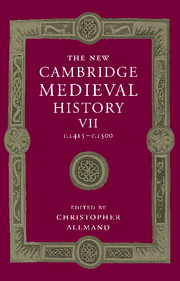Book contents
- Frontmatter
- PART I GOVERNMENT
- PART II ECONOMIC AND SOCIAL DEVELOPMENTS
- PART III SPIRITUAL, CULTURAL AND ARTISTIC LIFE
- 10 Religious Belief and Practice
- 11 Schools and Universities
- 12 Humanism
- 13 Manuscripts and Books
- 14 The Beginning of Printing
- 15 Architecture and Painting
- 16 Music
- PART IV THE DEVELOPMENT OF EUROPEAN STATES
- Appendix Genealogical Tables
- Primary Sources and Secondary Works Arranged by Chapter
- Index
- Frontispiece
- Plate section
- Map 1 European towns in the late Middle Ages
- Map 2 European commerce and trade
- Map 4 Winds and currents facilitating the discoveries
- Map 5 The universities o f Europe in 1400 and 1500
- Map 6 Germany and the Empire
- Map 20 The Roman Orthodox and Ottoman worlds in the fifteenth century
- References
13 - Manuscripts and Books
from PART III - SPIRITUAL, CULTURAL AND ARTISTIC LIFE
Published online by Cambridge University Press: 28 March 2008
- Frontmatter
- PART I GOVERNMENT
- PART II ECONOMIC AND SOCIAL DEVELOPMENTS
- PART III SPIRITUAL, CULTURAL AND ARTISTIC LIFE
- 10 Religious Belief and Practice
- 11 Schools and Universities
- 12 Humanism
- 13 Manuscripts and Books
- 14 The Beginning of Printing
- 15 Architecture and Painting
- 16 Music
- PART IV THE DEVELOPMENT OF EUROPEAN STATES
- Appendix Genealogical Tables
- Primary Sources and Secondary Works Arranged by Chapter
- Index
- Frontispiece
- Plate section
- Map 1 European towns in the late Middle Ages
- Map 2 European commerce and trade
- Map 4 Winds and currents facilitating the discoveries
- Map 5 The universities o f Europe in 1400 and 1500
- Map 6 Germany and the Empire
- Map 20 The Roman Orthodox and Ottoman worlds in the fifteenth century
- References
Summary
the production of books and manuscripts in the fifteenth century saw the culmination of tendencies which had begun during the latter part of the thirteenth century. The most significant of these were the increasing dominance of lay workshops over the scriptoria of religious houses; the rise of a commercialised book trade; and the emergence of veritable publishing houses in the major centres of European book production. The period none the less witnessed something of a revival in the copying of liturgical and devotional books by religious communities. It was also to see an invasion of the market by books produced by the new process of printing with movable type, and the eclipse of those book producers and dealers who did not adapt to the new techniques.
To satisfy the increasing demands of literate lay people, as well as the clergy, a more sophisticated organisation of the book trade was required. The single scribe, working alone, was still to be found, but he formed only one element in the complex process of book production. A structure dominated by entrepreneurs and middlemen was emerging and ‘in the [later] Middle Ages true publishing houses existed, in the modern sense of the word’. The best known of these were to be found in the Low Countries and in northern Italy, but there were comparable establishments in England, France and Germany.
Keywords
- Type
- Chapter
- Information
- The New Cambridge Medieval History , pp. 278 - 286Publisher: Cambridge University PressPrint publication year: 1998
References
- 2
- Cited by



